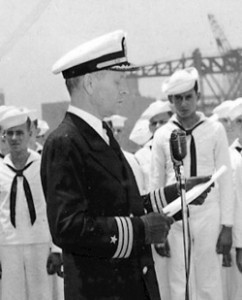Remember His Name
You probably don’t recognize the name of Albert Kaplan, and frankly that’s a damned shame.
In 1943, Commander Kaplan was the executive officer aboard the USS Mayo, a U.S. Navy destroyer operating in the European Theater. On September 13th, during the Battle of Salerno, the USS Mayo and the light cruiser USS Brooklyn were called in to support the U.S. Fifth Army, which was pinned down on the beach at Salerno, Italy by superior fire. Up against three German divisions, more than 600 tanks, and numerous mobile guns, the U.S. invasion force was in danger of being pushed back into the sea.
Commander Albert D. Kaplan
With his commanding officer out of action due to illness, Commander Kaplan assumed command of USS Mayo, and took the destroyer within 500 yards of the beachhead. Assisted by an Army spotter plane, the ship engaged in direct firefights with German ground forces, hammering the enemy tanks and gun emplacements with 5” naval artillery rounds. The ship’s fire was so accurate that the spotter pilot recommended shifting the guns to rapid fire. Commander Kaplan concurred with the recommendation, and gave the order for rapid fire. Within a minute, USS Mayo’s guns were pumping out a shell every four seconds.
By the end of the engagement, 46 Nazi tiger tanks lay in flaming ruins, and the Mayo’s gun barrels were so overheated that the gray paint was blackened and the gun boots were scorched to something resembling charcoal. (Every gun barrel on the ship had to be replaced following the battle.)
Official Navy statistics show that the USS Mayo fired 60% of all 5” artillery at Salerno. The ship was awarded a Battle Star for her part in the engagement, and she is remembered by history as the U.S. Navy’s “tank buster.” Her commanding officer, Commander Frederic S. Habecker, received the Legion of Merit for his ship’s heroic actions during the combat.
Sadly, the ship’s executive officer—the man who actually led the fight—has been virtually overlooked by history. I’m certainly not trying to smear the name of Commander Habecker, who was a hero in his own right many times over. According to the men who served under him, Habecker was a gifted leader, a true warrior, and a fine naval officer. But in this one crucial battle, it was his second in command who held the reins of leadership and carried the ship and crew to victory.
The world has all but forgotten the name of Albert Kaplan. When I learned about his extraordinary story, I decided to name a U.S. Navy destroyer after him in one of my books. If you’ve ever read The Seventh Angel, you may recall the scenes where USS Albert D. Kaplan operates alongside USS Towers at the edge of the Siberian ice pack. It’s a small thing—naming a fictional warship after a real hero—but it’s my own humble way of keeping alive the legacy of a man who rose to the challenge when his country needed him.
If we do nothing else for our heroes, we should at least remember their names.




